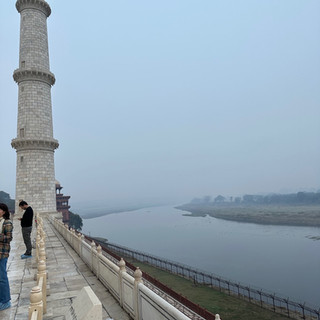Visiting the Taj (below) is of course a bucket list item for many. One of the questions I thought this trip would answer is whether 'wonders of the world' are really what they seem in famous photos and on instagram. Recalling Painted Mountain in Peru, and several other amazing places we've been fortunate to visit, The Taj is a beautiful monument. Built as a Tomb--a fantastic memorial--to the beloved Queen Mumtaz who birthed 14 children and died in childbirth, 6 of the children surviving. There were 4 sons and 2 daughters which of course resembles our clan. But the King was a bit of a spender and the youngest son thought he'd get neither the crown nor the jewels so he took matters into his own hands, He imprisoned his father for life, murdered his three older brothers and one sister who he had learned was plotting to kill him. His one sister was spared and allowed to visit her father. His room overlooked his wife's burial place, the Taj, from across the river. He was held at the castle but off in the stone space shown here. The murdering son who became King ruled for 50 years. Upon his death the empire crumbled.
We also visited the Agra fort, almost 1 kilometer long
and built by King Akbar the 3rd king. He consolidated the kingdom during his reign and also moved the royal family from Delhi to Agra.
Agra is 2.8 to 2.9 M people today.
Women wear yellow, gold, red, wine. Even for weddings they dont wear black or white. The sari colors and patterns are endless, from rich to poor, from ornate to basic, from warm to cold. I mention this now because women not only dress uniquely, they are treated differently, particularly in the olden days as noted below. But fear not, our guide proudly told us that women are allowed to earn a certain amount of income without paying any taxes. This is true today.
We probably learned more about concubines (always taken against their will), and the lives of Queens (the King who killed his siblings and imprisoned his father took 3 wives) and royal families than we need to. The palaces and forts are facinating though from a construction and architecture perspective given their age. For example you can see that the Queens quartees have no windows to the courtyard so the king could access the concubines without being seen, and the windows they did have resemble lace where you can see out through the holes, but its hard to be seen. Several examples of this design permeate Northern India.
A more recent add was the red palace which was created by the king in honor of the religous figure who blessed his desire for a child and his third wife finally got pregnant after 13 years of weddings and wives but no children. The palace had a lovely courtyard and larger housing for the wife that finally had a child. The other two Queens had much lesser quarters. The king was also very small in stature. There were several measures taken to make his spots--where he slept, where he greeted people, where he sat--elevated to minimize his height differential. Some of the images show the short doorways, low ceilings and high bed.
We went to the Taj early to avoid the lines and it was a bit overcast to say the least but still visible. The inside of the Taj does not permit cameras, but its more of the same with the beautifully carved floral limestone and inlayed colored flowers as shown in the front entrance portico . The original idea of thebm tomb was likely for the kids to be buried there too and the King, given the various empty wings, but the murderous son who became king did not permit his brother's remains to be found, and did bury his father next to his mother, off center in the main chamber. See TajII for the other images!





























































Comentarios